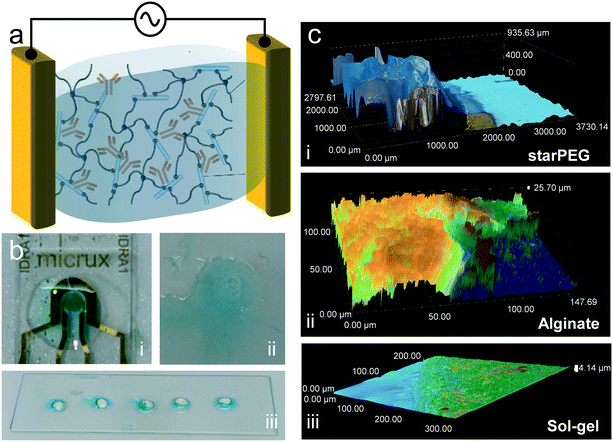Impedance spectroscopy-based biosensors are typically functionalized following two-dimensional immobilization strategies, with bioreceptors attached through crosslinkers. These methodologies may lead to a decreased receptor activity due to wrong orientation, conformational changes or limited interaction kinetics with the liquid sample. Entrapment of bioreceptors in hydrogels can tackle these issues offering a favourable three-dimensional fluid-like environment, while protecting the electrodes from biofouling in the presence of complex biological fluids at the same time. The star-shaped polyethylene glycol hydrogel doped with heparin (starPEG–heparin) represents a promising candidate, with its excellent hemocompatibility, but its biosensing performance has never been investigated. Here, we show the first demonstration of starPEG–heparin as a biosensor, using antibodies against immunoglobulin G as a model bioreceptor, and we compare it to the performance of other gels with alternative advantages: alginate, which provides easy fabrication and electrode regeneration possibilities, and silicate-based sol–gel, whose porosity can be tuned in a wide range. The starPEG–heparin outperforms the other two, being capable of detecting ultralow antigen concentrations down to the femtomolar levels, implemented in simple photolithography electrodes. We envision its integration in nanomaterial-based sensors which will further improve the sensitivity, and its application in full blood analysis or in implantable devices for in vivo biosensing.

Impedance spectroscopy-based biosensors are typically functionalized following two-dimensional immobilization strategies, with bioreceptors attached through crosslinkers. These methodologies may lead to a decreased receptor activity due to wrong orientation, conformational changes or limited interaction kinetics with the liquid sample. Entrapment of bioreceptors in hydrogels can tackle these issues offering a favourable three-dimensional fluid-like environment, while protecting the electrodes from biofouling in the presence of complex biological fluids at the same time. The star-shaped polyethylene glycol hydrogel doped with heparin (starPEG–heparin) represents a promising candidate, with its excellent hemocompatibility, but its biosensing performance has never been investigated. Here, we show the first demonstration of starPEG–heparin as a biosensor, using antibodies against immunoglobulin G as a model bioreceptor, and we compare it to the performance of other gels with alternative advantages: alginate, which provides easy fabrication and electrode regeneration possibilities, and silicate-based sol–gel, whose porosity can be tuned in a wide range. The starPEG–heparin outperforms the other two, being capable of detecting ultralow antigen concentrations down to the femtomolar levels, implemented in simple photolithography electrodes. We envision its integration in nanomaterial-based sensors which will further improve the sensitivity, and its application in full blood analysis or in implantable devices for in vivo biosensing.
